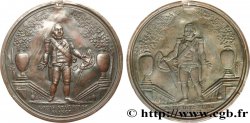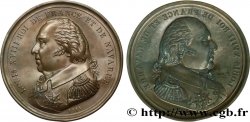fme_412334 - LOUIS XVIII Médaille de la Paix du Traité de Paris
Not available.
Item sold on our e-shop (2017)
Price : 180.00 €
Item sold on our e-shop (2017)
Price : 180.00 €
Type : Médaille de la Paix du Traité de Paris
Date: 1814
Mint name / Town : France
Metal : bronze
Diameter : 50,5 mm
Orientation dies : 12 h.
Engraver ANDRIEU Jean-Bertrand (1761-1822) / GATTEAUX Jacques-Édouard (1788-1881)
Weight : 64 g.
Edge : lisse
Coments on the condition:
Magnifique médaille avec une patine un peu nettoyée par endroits ?
Obverse
Obverse legend : LVDOVICVS XVIII - FRANC ET NAV REX.
Obverse description : Buste de Louis XVIII à droite, un cordon dans les cheveux.
Reverse
Reverse legend : IMPERIA . LEGITIMA . FOEDERE . SANCITA. // XII. MAI. MDCCCXIV.
Reverse description : Louis XVIII, les empereurs d'Autriche et de Russie, le roi d'Angleterre et le roi de Prusse, tous couronnés et en grand manteau prêtent serment sur un traité posé sur un autel orné d'une foi et de l'inscription "PACI ORBIS" ("à la paix du monde")..
Commentary
Médaille signée ANDRIEU F. sur le cou et DE PUYMAURIN DI. à l’exergue du droit et E. GATTEAUX F. au revers.
L’exemplaire du Musée Carnavalet semble avoir été frappé après cette médaille qui n’a pas la cassure de coin au droit.
Le traité de Paris du 30 mai 1814 fixe les frontières de la France après l'abdication de Napoléon Ier, exilé à l’île d'Elbe. Cet accord est remis en question par l'épisode des Cent-Jours et un nouveau traité est signé en 1815.
.
L’exemplaire du Musée Carnavalet semble avoir été frappé après cette médaille qui n’a pas la cassure de coin au droit.
Le traité de Paris du 30 mai 1814 fixe les frontières de la France après l'abdication de Napoléon Ier, exilé à l’île d'Elbe. Cet accord est remis en question par l'épisode des Cent-Jours et un nouveau traité est signé en 1815.
.








 Report a mistake
Report a mistake Print the page
Print the page Share my selection
Share my selection Ask a question
Ask a question Consign / sell
Consign / sell
 Full data
Full data









